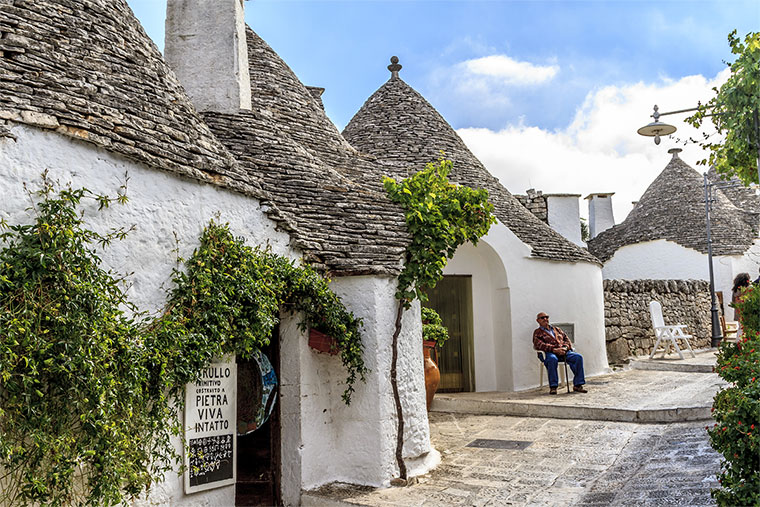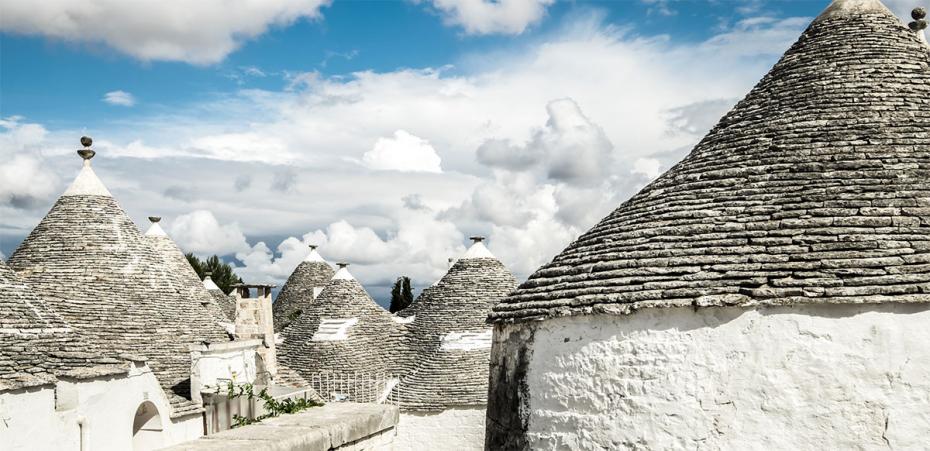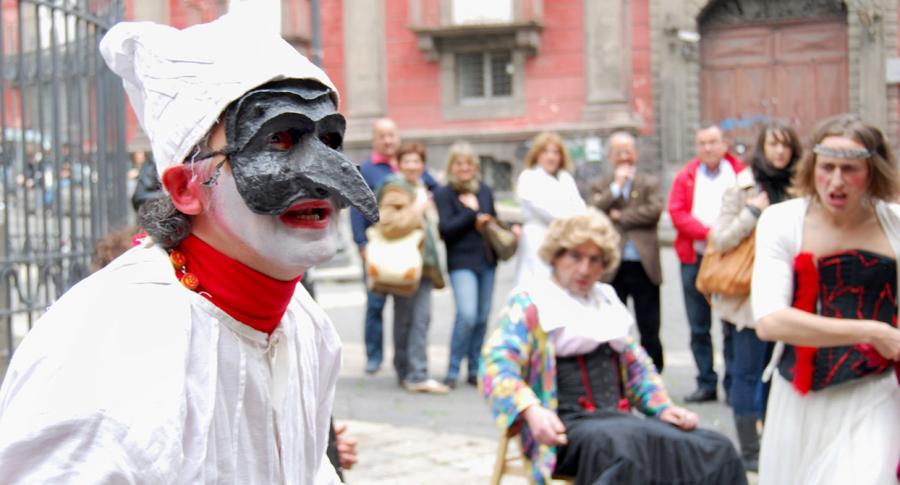The oddest-looking buildings in Italy are the arcane “trulli”, unique circular dry-stone buildings typical of the region of Puglia, the ancient Apulia. There is nothing like them anywhere in the world. They dot the valley of the Itria river in the Murgia area. These constructions are commonly called “trulli di Alberobello”, but they can also be found in other Apulian locations: Locorotondo, Fasano, Ostuni, Martina Franca, and others. But the largest number of these conical marvels is concentrated in Alberobello, a small town that looks like a fairy tale place. Alberobello was built on top of a hill surrounded by almond groves and olive trees, and its name means “beautiful tree.”
Such is the extraordinary appearance and magic beauty of these mysterious rural constructions that in 1996 UNESCO declared the Alberobello area a Patrimony of Humanity. Since then the interest in these particular dwellings has enormously increased, causing tourists from all over the world to flock to admire them, and even buy them and live in them.

When I first visited Alberobello I was a curious teenager. Then the location was not well known, and not many tourists visited it. At that time the “trulli” villages were eerily quiet and almost empty; many of the buildings were left in disarray, many were abandoned, and silence reigned over them.
Things are certainly different now after the area was declared a part of the UNESCO Patrimony of Humanity. For those who do not know, UNESCO stands for the UNITED NATIONS EDUCATIONAL, SCIENTIFIC AND CULTURAL ORGANIZATION “that seeks to encourage the identification, protection and preservation of cultural and natural heritage around the world considered to be of outstanding value to humanity.” (Their definition). “Places as unique and diverse as the wilds of East Africa’s Serengeti, the Pyramids of Egypt, the Great Barrier Reef in Australia and the Baroque cathedrals of Latin America make up our world’s heritage.” (Again, their definition). So the humble “trulli” are in good company.
Let us go over the history of these unusual abodes. First of all, the word “trullo” is the Apulian rendition of the Greek word for dome, since each conical building is capped by a dome. In the local dialect the “trullo” is called “truddu.” A builder of “trulli” is called a “trullaro.” There are still some of them alive. The “trulli” are unique peasant houses, consisting of rounded structures with cone-shaped, gray stone roofs, set on a base of limestone slabs.

The very thick walls are also made of stones simply collected in the neighboring fields. The “trulli” (singular “trullo”) are always painted white, and are generally whitewashed every year. What makes the “trullo” very special from an architectural point of view is that the stones forming it are put together without mortar, but with a precise prehistoric technique still in use in this region today.
The origins of the “trulli” are unknown. According to some theories, they date back five thousand years. But other historians date them back to the fifteenth century, and claim that their peculiar shape arose as a tax evasion ruse. In feudal times, anyone erecting a dwelling on the King’s land had to pay a tax. The inhabitants of Puglia devised the dry-stone “trullo” as a way to evade taxes. At the first notice of the tax collector’s arrival, the “trulli” were rapidly dismantled, moved and rebuilt again afterwards. But this is of course a legend! Nowadays, the “trulli” are firmly planted on the ground and buttressed with stucco.
When I first saw Alberobello, I felt I had arrived in a land of make believe. The caps on the roofs seemed to me like little winter bonnets worn by elves. I was impressed by the conical shapes, but even more by the diverse decorations drawn or etched on them. The “trulli” are adorned with fanciful hex signs and mysterious designs that add magic to the already bewitching scenery. On the conic roofs are inscribed emblems and symbolic shapes of all kinds. The majority of the signs are of religious origin and content. We find Christian signs, such as the Cross, the Sacred Heart, and others. Some symbols are pagan: the rooster, the serpent, the horseshoe, the horns, and so on. Others yet are simply geometric: circles, triangles, zigzag lines.
There are also designs drawn from astronomy and planetary drawings of the zodiac. Other signs are simply ornamental, like the cornucopia, and others may be the fruit of the fertile imagination of the builder.
The “trulli” have been called “living stones” because they contain and embrace the lives of their inhabitants. Traditionally, each “trullo” consists of one vast round room only with one entrance door. Once in a while, you see a conglomeration of three, four or five “trulli” interconnected among themselves. But that is rare. The circular space within one “trullo” contains the kitchen, the bedroom, the storeroom and, in the old times, even the animal shelter. More space is eaked out from the thick walls, where some recesses are dug out for sleeping areas, which are hidden by courtains.
The restored, modernized “trulli” now have bathrooms and bathroom doors, of course. The simple, sturdy furniture is generally handmade by local craftsmen, and made mostly of olive wood. The hearth is the source of heat in the winter, and for this reason there is a flue in the ceiling. Puglia is a fairly hot southern region, and in the summer the stones protect one from the hot sun. In the winter the thickness of the walls keep the warmth inside.
The “trulli” remind one of houses you see in the Greek islands, or on the Southern Italian Aeolian islands. The whiteness that pervades the towns and villages is refreshing to the eye and to the mind. I encourage everyone to visit Puglia, to see not only the “trulli” of Alberobello, but also other architectural marvels of this ancient land and its scenic coastline.
The “trulli” have been internationally recognized for the magical buildings they are. And the region that created them, Puglia, enchants visitors with its simple and arcane architecture. The British and Germans especially find the region delightful. Many have bought abandoned and dilapidated “trulli” and have remodeled them to use them as a summerhouse.
Puglia itself is a bargain for the tourist compared to the rest of Italy, and the people of Puglia are especially welcoming, honest and generous. Nowadays, there are very good hotels for the tourists’ comfort, and one can even find a very comfortable bed and breakfast to stay in!































